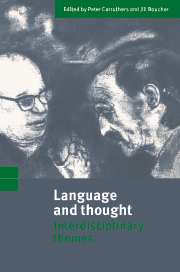Book contents
- Frontmatter
- Contents
- List of contributors
- Preface
- 1 Introduction: opening up options
- Part I Language, development and evolution
- Part II Language, reasoning and concepts
- Part III Language and conscious reasoning
- Introduction to part III
- 11 Language, thought and the language of thought (Aunty's own argument revisited)
- 12 Natural language and virtual belief
- 13 The meta-intentional nature of executive functions and theory of mind
- 14 Reflections on language and mind
- References
- Author index
- Subject index
13 - The meta-intentional nature of executive functions and theory of mind
Published online by Cambridge University Press: 08 January 2010
- Frontmatter
- Contents
- List of contributors
- Preface
- 1 Introduction: opening up options
- Part I Language, development and evolution
- Part II Language, reasoning and concepts
- Part III Language and conscious reasoning
- Introduction to part III
- 11 Language, thought and the language of thought (Aunty's own argument revisited)
- 12 Natural language and virtual belief
- 13 The meta-intentional nature of executive functions and theory of mind
- 14 Reflections on language and mind
- References
- Author index
- Subject index
Summary
Introduction
There is a strong intuition that what we express linguistically we are (on the whole) conscious of, and Dennett (1978) has seen the essence of conscious thought in the availability of its contents to verbal report. On intuitive grounds a similarly close relationship exists between consciousness and voluntary control. In fact, Jacoby's (1991) famous ‘process dissociation procedure’ for determining the relative contributions of implicit/unconscious and explicit/conscious information to performance in memory or subliminal perception tasks (Debner and Jacoby, 1994) presupposes that conscious information consists of those contents of memory over which one can exert voluntary control. And naturally, voluntary control in these experiments consists in the ability to implement the verbal instructions, to either include or exclude specified events of the past in one's test answers.
I now want to analyse the representational pre-requisites for controlled action at some length in order to show that it requires a meta-intentional representation of one's own intentions. This requirement then provides the basis for explaining its kinship with language and conscious thought.
The close link between conscious processing of verbal information and (executive) control is also emphasised in the more standard model of working memory. I chose the term Executive Function (e.g., Ozonoff et al. 1991) as a generic term for those functions that are allegedly served by, e.g., the Central Executive within working memory (Baddeley and Hitch, 1974) or the Supervisory Attentional System (SAS) of Norman and Shallice (1980/1986), which all bear a close family resemblance to each other (Shallice and Burgess, 1993, p. 173).
- Type
- Chapter
- Information
- Language and ThoughtInterdisciplinary Themes, pp. 270 - 283Publisher: Cambridge University PressPrint publication year: 1998
- 45
- Cited by



